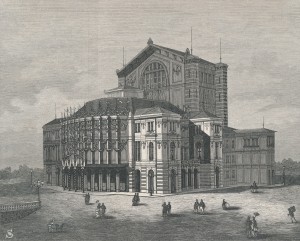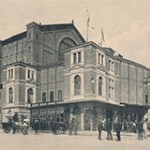 Biography VII.
Biography VII.
THE BAYREUTH YEARS
(1864-1870)
While a a non-disguized anti-Wagnerian sentiment grew in France – this occured just a few months after French nation had just lost the war of 1870 against Prussia – Wagner, from hi side, was finally about to make his lifelong dream true… and concrète !
In full creative verve, Richard Wagner refined his project to assemble the entirety of The Ring of the Nibelung (Der Ring des Nibelungen) at the Margravial Opera House of Bayreuth or on the stage of a theatre that would be entirely dedicated to the performance of his work. The composer announced it to King Ludwig II of Bavaria, who put on a brave face, despite his discontent.
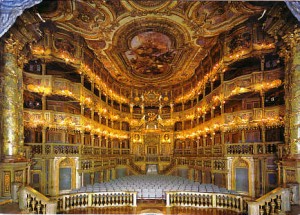 To finance this ambitious dream, Wagner took advantage of a trip to Berlin to set up a “Patronatsverein” – a sponsorship association – to gather financing for the future Bayreuth Festival. According to the charter of this committee, each of the members would be awarded one of the thousand places of the Festival being created. The committee was under the direction of Marie von Schleinitz, wife of Prussian Minister Alexander von Schleinitz. Wagner also tried to obtain subsidies from Chancellor Otto von Bismarck, but without success. The visionary composer understood that “the expenses of [his] undertaking shall only be collected by private individuals” (in a letter to von Düfflip).
To finance this ambitious dream, Wagner took advantage of a trip to Berlin to set up a “Patronatsverein” – a sponsorship association – to gather financing for the future Bayreuth Festival. According to the charter of this committee, each of the members would be awarded one of the thousand places of the Festival being created. The committee was under the direction of Marie von Schleinitz, wife of Prussian Minister Alexander von Schleinitz. Wagner also tried to obtain subsidies from Chancellor Otto von Bismarck, but without success. The visionary composer understood that “the expenses of [his] undertaking shall only be collected by private individuals” (in a letter to von Düfflip).
Among these good intentions were in December 1871 the authorities of the city of Bayreuth (represented by the mayor Theodor Muncker) who made available to the composer a building lot perched on a hill outside of the city, the Bürgerreuth, for 14,000 guldens. On the way to Bayreuth then. In April 1872, Wagner definitively left Tribschen.
On 22 May, the day of his birthday, took place the inauguration of the Festspielhaus site in Bayreuth, on the music of the Huldigungsmarsch. For the occasion came Friedrich Nietzsche, Karl Ritter, Heinrich Porges, Peter Cornelius, Malwida von Meysenburg…
The place – the future temple! – was being built, it was time to think about the artists. Once again on the roads, the Wagners undertook a trip to Germany to recruit singers for the performances of The Ring of the Nibelung in Bayreuth: Würzburg, Frankfurt am Main, Darmstadt and Mannheim.
On May 22, 1873, Wagner celebrated his 60th birthday. One year had passed since the beginning of the work. The project was longer than expected. Despite his hopes, the performances of The Ring of the Nibelung on the ideal stage could not take place in 1873. Wagner announced a deferment for 1875 due to a lack of liquidity and left to seek the required funds. Alas the doors (and pocketbooks) hardly opened. In 1874, while the project was on the brink of bankruptcy, Ludwig II, his unwavering patron, came despite the past disputes to Wagner’s rescue.
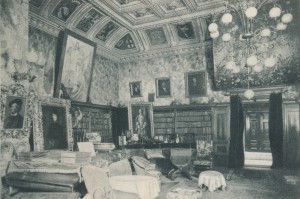 Thus the Bayreuth project averted failure thanks to a temporary rescue from the crown of Bavaria (and more precisely, from the personal assets of the king). Relieved, Richard Wagner moved with Cosima on April 28, 1874 in the Villa Wahnfried, for the construction of which King Ludwig II of Bavaria also contributed 25,000 thalers. When in August 1874 Friedrich Nietzsche stayed at Wahnfried, a dispute cracked the friendship that bound the two men. But Wagner had only one goal in mind at that time: the advent of the Festival.
Thus the Bayreuth project averted failure thanks to a temporary rescue from the crown of Bavaria (and more precisely, from the personal assets of the king). Relieved, Richard Wagner moved with Cosima on April 28, 1874 in the Villa Wahnfried, for the construction of which King Ludwig II of Bavaria also contributed 25,000 thalers. When in August 1874 Friedrich Nietzsche stayed at Wahnfried, a dispute cracked the friendship that bound the two men. But Wagner had only one goal in mind at that time: the advent of the Festival.
In 1875, lacking money again, the Wagners left for a series of concerts intended to finance the project. The preliminary rehearsals in Bayreuth began on July 1, 1875, under the direction of Hans Richter, and then of Hermann Levi. But further deferment arose: although on 1 August, 1875 the construction work on the Festspielhaus was finally completed, the year 1876 was still dedicated to fundraising. The couple went to Berlin to Emperor William I. Some resources were delightedly welcome: the composer received the commission in 1876 for a “Grossen Festmarsch” (Great March for the festivities of the Centennial of American Independence WWV110). Finally, in June 1876, began the (real) rehearsals of The Ring of the Nibelung at the Festspielhaus and on August 13, 1876 was the grand opening of the first Bayreuth Festival: under the direction of Hans Richter, a performance of The Rhinegold (Das Rheingold) on 13th, The Valkyrie (Die Walküre) on the 14th, Siegfried on the 16th and Twilight of the Gods (Götterdämmerung) on the 17th. The first edition of the Festival was met with exceptional musical success, mixed artistic success and a financial meltdown. Indeed, despite the success, despite the financial assistance and despite the personal contributions of the Wagners, the Festival generated a huge deficit of 148,000 marks.
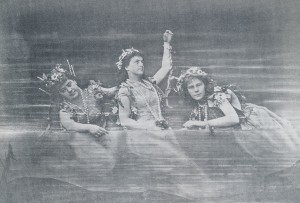
Exhausted, Richard Wagner travelled to Italy and visited Verona, Venice, Bologna, Naples, Sorrento (where he met Friedrich Nietzsche for the last time), Rome and Florence. The composer was then tempted, and convinced, to sell the rights to the performances of The Ring of the Nibelung beyond the borders of Bayreuth in order to finance a second festival. Richard Wagner was indeed already thinking of Parsifal …
NC/SB.
![]()
If you wish to share further information about this article, please feel free to contact us !
